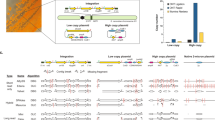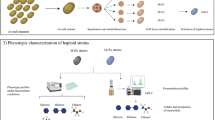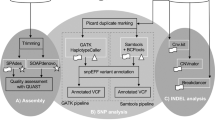Abstract
Tetrad analysis has been a gold-standard genetic technique for several decades. Unfortunately, the need to manually isolate, disrupt and space tetrads has relegated its application to small-scale studies and limited its integration with high-throughput DNA sequencing technologies. We have developed a rapid, high-throughput method, called barcode-enabled sequencing of tetrads (BEST), that uses (i) a meiosis-specific GFP fusion protein to isolate tetrads by FACS and (ii) molecular barcodes that are read during genotyping to identify spores derived from the same tetrad. Maintaining tetrad information allows accurate inference of missing genetic markers and full genotypes of missing (and presumably nonviable) individuals. An individual researcher was able to isolate over 3,000 yeast tetrads in 3 h, an output equivalent to that of almost 1 month of manual dissection. BEST is transferable to other microorganisms for which meiotic mapping is significantly more laborious.
This is a preview of subscription content, access via your institution
Access options
Subscribe to this journal
Receive 12 print issues and online access
$259.00 per year
only $21.58 per issue
Buy this article
- Purchase on Springer Link
- Instant access to full article PDF
Prices may be subject to local taxes which are calculated during checkout



Similar content being viewed by others
References
Winge, Ö. & Laustsen, O. On two types of spore germination, and on genetic segregations in Saccharomyces, demonstrated through single-spore cultures. C.R. Trav. Lab. Carlsberg Ser. Physiol. 22, 99–116 (1937).
Amberg, D.C., Burke, D.J. & Strathern, J.N. Random spore analysis in yeast. CSH Protoc. 2006, pii: pdb.prot4162 (2006).
Tong, A.H. et al. Systematic genetic analysis with ordered arrays of yeast deletion mutants. Science 294, 2364–2368 (2001).
Pan, X. et al. A robust toolkit for functional profiling of the yeast genome. Mol. Cell 16, 487–496 (2004).
Schuldiner, M. et al. Exploration of the function and organization of the yeast early secretory pathway through an epistatic miniarray profile. Cell 123, 507–519 (2005).
Snitkin, E.S. et al. Model-driven analysis of experimentally determined growth phenotypes for 465 yeast gene deletion mutants under 16 different conditions. Genome Biol. 9, R140 (2008).
Michelmore, R.W., Paran, I. & Kesseli, R.V. Identification of markers linked to disease-resistance genes by bulked segregant analysis: a rapid method to detect markers in specific genomic regions by using segregating populations. Proc. Natl. Acad. Sci. USA 88, 9828–9832 (1991).
Ehrenreich, I.M. et al. Dissection of genetically complex traits with extremely large pools of yeast segregants. Nature 464, 1039–1042 (2010).
Mackay, T.F., Stone, E.A. & Ayroles, J.F. The genetics of quantitative traits: challenges and prospects. Nat. Rev. Genet. 10, 565–577 (2009).
Fogel, S., Mortimer, R., Lusnak, K. & Tavares, F. Meiotic gene conversion: a signal of the basic recombination event in yeast. Cold Spring Harb. Symp. Quant. Biol. 43, 1325–1341 (1979).
Lander, E.S. Initial impact of the sequencing of the human genome. Nature 470, 187–197 (2011).
Coluccio, A. & Neiman, A.M. Interspore bridges: a new feature of the Saccharomyces cerevisiae spore wall. Microbiology 150, 3189–3196 (2004).
Chin, B.L., Frizzell, M.A., Timberlake, W.E. & Fink, G.R. FASTER MT: isolation of pure populations of a and α ascospores from Saccharomyces cerevisiae. G3 (Bethesda) 2, 449–452 (2012).
Gerke, J.P., Chen, C.T. & Cohen, B.A. Natural isolates of Saccharomyces cerevisiae display complex genetic variation in sporulation efficiency. Genetics 174, 985–997 (2006).
Thacker, D., Lam, I., Knop, M. & Keeney, S. Exploiting spore-autonomous fluorescent protein expression to quantify meiotic chromosome behaviors in Saccharomyces cerevisiae. Genetics 189, 423–439 (2011).
Yan, Z. et al. Yeast Barcoders: a chemogenomic application of a universal donor-strain collection carrying bar-code identifiers. Nat. Methods 5, 719–725 (2008).
Armstrong, K.A., Som, T., Volkert, F.C., Rose, A. & Broach, J.R. Propagation and expression of genes in yeast using 2-micron circle vectors. Biotechnology 13, 165–192 (1989).
Mancera, E., Bourgon, R., Brozzi, A., Huber, W. & Steinmetz, L.M. High-resolution mapping of meiotic crossovers and non-crossovers in yeast. Nature 454, 479–485 (2008).
Baird, N.A. et al. Rapid SNP discovery and genetic mapping using sequenced RAD markers. PLoS ONE 3, e3376 (2008).
Winston, F., Dollard, C. & Ricupero-Hovasse, S.L. Construction of a set of convenient Saccharomyces cerevisiae strains that are isogenic to S288C. Yeast 11, 53–55 (1995).
Dowell, R.D. et al. Genotype to phenotype: a complex problem. Science 328, 469 (2010).
Mortimer, R.K. & Johnston, J.R. Genealogy of principal strains of the yeast genetic stock center. Genetics 113, 35–43 (1986).
Sniegowski, P.D., Dombrowski, P.G. & Fingerman, E. Saccharomyces cerevisiae and Saccharomyces paradoxus coexist in a natural woodland site in North America and display different levels of reproductive isolation from European conspecifics. FEMS Yeast Res. 1, 299–306 (2002).
Rose, M.D., Winston, F.M. & Hieter, P. Methods in Yeast Genetics: A Laboratory Course Manual (Cold Spring Harbor, 1990).
Brachmann, C.B. et al. Designer deletion strains derived from Saccharomyces cerevisiae S288C: a useful set of strains and plasmids for PCR-mediated gene disruption and other applications. Yeast 14, 115–132 (1998).
Gietz, R.D. & Woods, R.A. Transformation of yeast by lithium acetate/single-stranded carrier DNA/polyethylene glycol method. Methods Enzymol. 350, 87–96 (2002).
Lorenz, K. & Cohen, B.A. Small- and large-effect quantitative trait locus interactions underlie variation in yeast sporulation efficiency. Genetics 192, 1123–1132 (2012).
Li, H. & Durbin, R. Fast and accurate short read alignment with Burrows-Wheeler transform. Bioinformatics 25, 1754–1760 (2009).
Li, H. et al. The Sequence Alignment/Map format and SAMtools. Bioinformatics 25, 2078–2079 (2009).
Kurtz, S. et al. Versatile and open software for comparing large genomes. Genome Biol. 5, R12 (2004).
Acknowledgements
We thank B. Cohen, A. Sherman and members of the Dudley lab for helpful discussions, and we thank B. Cohen (Washington University in St. Louis) for providing S. cerevisiae strain BC257. We thank D. Nickerson and B. Paeper for assistance with Illumina HiSeq 2000 sequencing and S. Bloom for assistance with Illumina GA IIx sequencing. This work was supported by a US National Institutes of Health–National Human Genome Research Institute (NIH/NHGRI) Genome Scholar/Faculty Transition Award (K22 HG002908) to A.M.D. and a strategic partnership between the Institute for Systems Biology and the University of Luxembourg. We note with sadness the passing of our friend and coauthor T.L. Gilbert.
Author information
Authors and Affiliations
Contributions
C.L.L., A.C.S., A.S., E.W.J., T.L.G. and A.M.D. contributed to experimental design; A.C.S. and C.L.L. contributed strains and plasmids; A.C.S., A.S., M.H., C.L.L., E.W.J. and T.L.G. contributed to experiments; G.A.C., A.C.S., P.M. and J.L. contributed to data analysis and scripts; and A.C.S., C.L.L., G.A.C. and A.M.D. wrote the manuscript.
Corresponding author
Ethics declarations
Competing interests
The authors declare no competing financial interests.
Supplementary information
Supplementary Text and Figures
Supplementary Figures 1–4, Supplementary Tables 9–11 and Supplementary Note (PDF 351 kb)
Supplementary Table 1
Polymorphism table for ∑1278B (TXT 1146 kb)
Supplementary Table 2
Polymorphism table for YPS163 (TXT 2133 kb)
Supplementary Table 3
RAD-seq genotypes of FY4 × ∑1278b (pilot) progeny strains (no imputation) (TXT 331 kb)
Supplementary Table 4
RAD-seq genotypes of FY4 × ∑1278b (pilot) progeny strains in three- or four-spore tetrads (including imputed markers and inferred genotypes of missing spores) (TXT 290 kb)
Supplementary Table 5
RAD-seq genotypes of S288c × YPS163 (pilot) progeny strains (no imputation) (TXT 592 kb)
Supplementary Table 6
RAD-seq genotypes of S288c × YPS163 (pilot) progeny strains in three- or four-spore tetrads (including imputed markers and inferred genotypes of missing spores) (TXT 505 kb)
Supplementary Table 7
RAD-seq genotypes of FY4 × ∑1278b (full scale) progeny strains (no imputation) (TXT 4355 kb)
Supplementary Table 8
RAD-seq genotypes of FY4 × ∑1278b (full scale) progeny strains in three- or four-spore tetrads (including imputed markers and inferred genotypes of missing spores) (TXT 3325 kb)
Rights and permissions
About this article
Cite this article
Ludlow, C., Scott, A., Cromie, G. et al. High-throughput tetrad analysis. Nat Methods 10, 671–675 (2013). https://doi.org/10.1038/nmeth.2479
Received:
Accepted:
Published:
Issue Date:
DOI: https://doi.org/10.1038/nmeth.2479
This article is cited by
-
Detection of genomic loci associated with chromosomal recombination using high-density linkage mapping in Setaria
Scientific Reports (2017)
-
Dissecting meiotic recombination based on tetrad analysis by single-microspore sequencing in maize
Nature Communications (2015)



